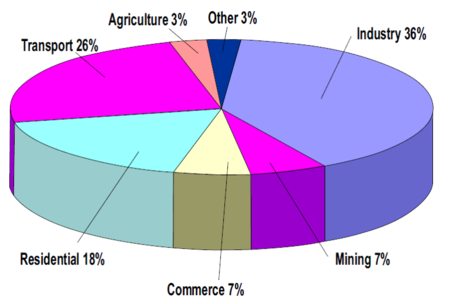Knowledge fuels change
For over a decade, Energypedia has shared free, reliable energy expertise with the world.
We’re now facing a serious funding gap.
Help keep this platform alive — your donation, big or small, truly matters!
Thank you for your support
Difference between revisions of "South Africa Energy Situation"
From energypedia
***** (***** | *****) |
***** (***** | *****) |
||
| Line 21: | Line 21: | ||
| style="width: 250px; background-color: rgb(219, 229, 241);" colspan="3" | '''Temperature Range (<span style="line-height: 1.5em;">⁰C</span>)''' | | style="width: 250px; background-color: rgb(219, 229, 241);" colspan="3" | '''Temperature Range (<span style="line-height: 1.5em;">⁰C</span>)''' | ||
| style="width: 250px; background-color: rgb(219, 229, 241);" | 25°C is the average temperature during Summers(November to March) and 10°C is the average lowest temperature during winters(June to August) | | style="width: 250px; background-color: rgb(219, 229, 241);" | 25°C is the average temperature during Summers(November to March) and 10°C is the average lowest temperature during winters(June to August) | ||
| + | |- | ||
| + | | style="width: 250px; background-color: rgb(219, 229, 241);" colspan="3" | '''Altitude(s) (m above MSL)''' | ||
| + | | style="width: 250px; background-color: rgb(219, 229, 241);" | Lowest altitude is 0 m(Sea level) and highest is 3450m | ||
|- | |- | ||
| style="width: 250px; background-color: rgb(219, 229, 241);" colspan="3" | '''Government''' | | style="width: 250px; background-color: rgb(219, 229, 241);" colspan="3" | '''Government''' | ||
| Line 91: | Line 94: | ||
| style="width: 250px; background-color: rgb(219, 229, 241);" colspan="3" | '''Usable land area for PV <span style="line-height: 21px;">( </span>km²<span style="line-height: 21px;">)</span>''' | | style="width: 250px; background-color: rgb(219, 229, 241);" colspan="3" | '''Usable land area for PV <span style="line-height: 21px;">( </span>km²<span style="line-height: 21px;">)</span>''' | ||
| style="width: 250px; background-color: rgb(219, 229, 241);" | 1062665(87% of Total land Area) | | style="width: 250px; background-color: rgb(219, 229, 241);" | 1062665(87% of Total land Area) | ||
| + | |- | ||
| + | | style="width: 250px; background-color: rgb(219, 229, 241);" colspan="3" | '''Seismic activity''' | ||
| + | | style="width: 250px; background-color: rgb(219, 229, 241);" | The south-western Cape has one of the highest levels of seismicity in South Africa.Historically, the most severe earthquake of magnitude 6.3 occurred on 29 September 1969 in Ceres, 100 km northeast of Cape Town. The event resulted in 12 lost lives and numerous damaged buildings in the town of Tulbagh. On 4 September 1809, a seismic event estimated at magnitude 6.3, occurred at the Milnerton Fault, a mere 10km from Cape Town CBD and the location of the Cape Town Stadium. | ||
|} | |} | ||
| Line 161: | Line 167: | ||
<br/> | <br/> | ||
| + | [[Category:Country_Energy_Situation]] | ||
[[Category:South_Africa]] | [[Category:South_Africa]] | ||
| − | |||
Revision as of 16:42, 7 November 2013
| South Africa | |||
|---|---|---|---|
| Capital | Pretoria | ||
| Official Languages(s) | 11 Official languages with Zulu being the most spoken language. | ||
| Political Stability | Democratic Republic | ||
| Climate Zone | Tropical (Tropical wet and dry) | ||
| Temperature Range (⁰C) | 25°C is the average temperature during Summers(November to March) and 10°C is the average lowest temperature during winters(June to August) | ||
| Altitude(s) (m above MSL) | Lowest altitude is 0 m(Sea level) and highest is 3450m | ||
| Government | |||
| President | Jacob Zuma | ||
| 'Total Area '( km²) | 1219090 | ||
| Population | 50586757 | ||
| Rural Population | (year) | ||
| GDP (Nominal) | US $ 471178 Billion (2011) | ||
| GDP Per Capita | US $ (year) | ||
| Currency | Rand | ||
| Time Zone | UTC/GMT +2 hours | ||
| Electricity Generation | TWh/year (year) | ||
| Access to Electricity | 75 % | ||
| Wind energy (installed capacity) | MW (year) | ||
| Solar Energy (installed capacity) | MW (year) | ||
| Literacy Rate | 89 % | ||
| South African currency against Euro | 1 Euro ~ 11 South African Rand (ZAR)
| ||
|
Government and Public Authorities (having Jurisdiction)
|
NERSA ( National energy regulator of South Africa) DoE (Department of Energy) DWEA (Department of water and Environmental affairs) | ||
| Institutes (research etc) |
SABS (South Africa Bureau of Standards) SANEDI ( South Africa National Energy Development Institute) SANERI (South Africa National Energy Research Institute) | ||
| Usable land area for PV ( km²) | 1062665(87% of Total land Area) | ||
| Seismic activity | The south-western Cape has one of the highest levels of seismicity in South Africa.Historically, the most severe earthquake of magnitude 6.3 occurred on 29 September 1969 in Ceres, 100 km northeast of Cape Town. The event resulted in 12 lost lives and numerous damaged buildings in the town of Tulbagh. On 4 September 1809, a seismic event estimated at magnitude 6.3, occurred at the Milnerton Fault, a mere 10km from Cape Town CBD and the location of the Cape Town Stadium. | ||
Overview
The South African energy supply is dominated by coal.
•Coal supplies 65.7% of the primary energy*
•Followed by crude oil with 21.6%
•Renewable and wastes with 7.6 %
•Gas with 2.8%
•Nuclear 0.4%
•Hydro 0.1%
*Primary Energy: an energy form found in nature that has not been subjected to any conversion or transformation process to become electrical energy, refined fuels, or synthetic fuels such as hydrogen fuel
Energy Sources
Hydropower
Solar Energy
Biomass
Biogas
Wind Energy
Geothermal Energy
Fossil Fuels
Key Problems of the Energy Sector
Policy Framework, Laws and Regulations
General Energy Policy, Energy Strategy
Important Laws and Regulations
Specific Strategies
(Biomass, Renewable Energies, Rural Electrification, Energy Access Strategy, Poverty Reduction Strategy etc.)
Institutional Set-up in the Energy Sector
Activities of Donors and Implementing Agencies
Further Information
References




















